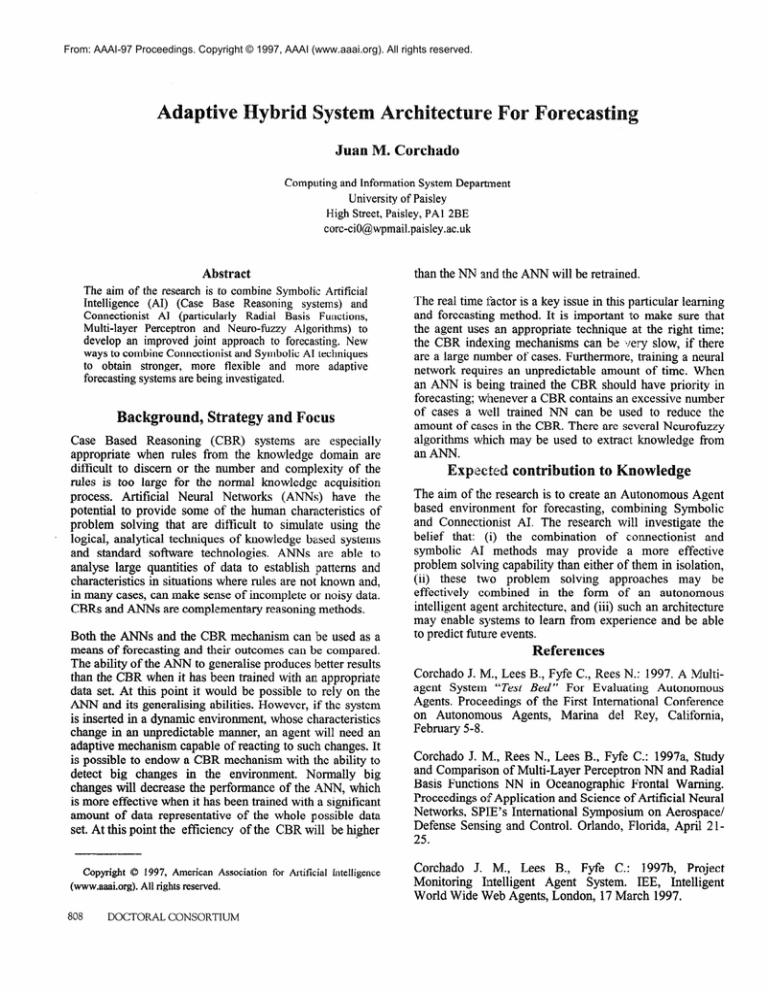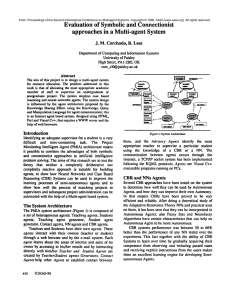
From: AAAI-97 Proceedings. Copyright © 1997, AAAI (www.aaai.org). All rights reserved.
Juan M. Corchado
Computing and Information System Department
University of Paisley
High Street, Paisley, PA1 2BE
core-ciO@wpmail.paisley.ac.uk
Abstract
The aim of the research is to combine Symbolic Artificial
Intelligence
(AI) (Case Base Reasoning
systems) and
Connectionist
AJ (particularly
Radial Basis Functions,
Multi-layer Perceptron
and Neuro-fuzzy
Algorithms)
to
develop an improved joint approach to forecasting. New
ways to combine Connection& and Symbolic AI techniques
to obtain stronger, more flexible and more adaptive
forecasting systems are being investigated.
ackground,
Strategy and Focus
Case Based Reasoning
(CBR) systems are especially
appropriate when rules from the knowledge domain are
difficult to discern or the number and complexity of the
rules is too large for the normal knowledge acquisition
process. Artificial
Neural Networks (ANNs) have the
potential to provide some of the human characteristics of
problem solving that are difficult to simulate using the
logical, analytical techniques of knowledge based systems
and standard software technologies.
ANNs are able to
analyse large quantities of data to establish patterns and
characteristics in situations where rules are not known and,
in many cases, can make sense of incomplete or noisy data.
CBRs and ANNs are complementary reasoning methods.
Both the ANNs and the CBR mechanism can be used as a
means of forecasting and their outcomes can be compared.
The ability of the ANN to generalise produces better results
than the CBR when it has been trained with an appropriate
data set. At this point it would be possible to rely on the
ANN and its generalising abilities. However, if the system
is inserted in a dynamic environment, whose characteristics
change in an unpredictable manner, an agent will need an
adaptive mechanism capable of reacting to such changes. It
is possible to endow a CBR mechanism with the ability to
detect big changes in the environment.
Normally big
changes will decrease the performance of the &4NN, which
is more effective when it has been trained with a significant
amount of data representative
of the whole possible data
set. At this point the efficiency of the CBR will be higher
,
Copyright 0 1997, American Association for Artificial Intelligence
(www.aaai.org). All rights reserved.
808
DOCTORAL CONSORTIUM
than the NN and the ANN will be retrained.
The real time factor is a key issue in this particular learning
and forecasting method. It is important to make sure that
the agent uses an appropriate technique at the right time;
the CBR indexing mechanisms can be ;/cry slow, if there
are a large number of cases Furthermore, training a neural
network requires an unpredictable
amount of time. When
an ANN is being trained the CBR should have priority in
forecasting; whenever a CBR contains an excessive number
of cases a well trained NN can be used to reduce the
amount of cases in the CBR. There are several Neurofuzzy
algorithms which may be used to extract knowledge from
an ANN.
Expiwxl
contrib
&ion to Knowledge
The aim of the research is to create an Autonomous Agent
based environment
for forecasting, combining
Symbolic
and Connectionist
AI. The research will investigate the
belief that: (i) the combination
of connectionist
and
symbolic AI methods may provide a more effective
problem solving capability than either of them in isolation,
(ii) these two problem
solving
approaches
may be
effectively
combined
in the form of an autonomous
intelligent agent architecture, and (iii) such an architecture
may enable systems to learn from experience and be able
to predict future events.
References
Corchado J. M., Lees B., Fyfe C., Rees N.: 1997. A Multiagent System “Test Bed ” For Evaluating
Autonomous
Agents. Proceedings of the First International
Conference
on Autonomous
Agents, Marina de1 Rey, California,
February 5-8.
Corchado J. M., Rees N., Lees B., Fyfe C.: 1997a, Study
and Comparison of Multi-Layer Perceptron NN and Radial
Basis Functions NN in Oceanographic
Frontal Warning.
Proceedings of Application and Science of Artificial Neural
Networks, SPIE’s International Symposium on Aerospace/
Defense Sensing and Control. Orlando, Florida, April 2 l25.
Corchado J. M., Lees B., Fyfe C.: 1997b, Project
Monitoring
Intelligent
Agent System. IEE, Intelligent
World Wide Web Agents, London, 17 March 1997.






